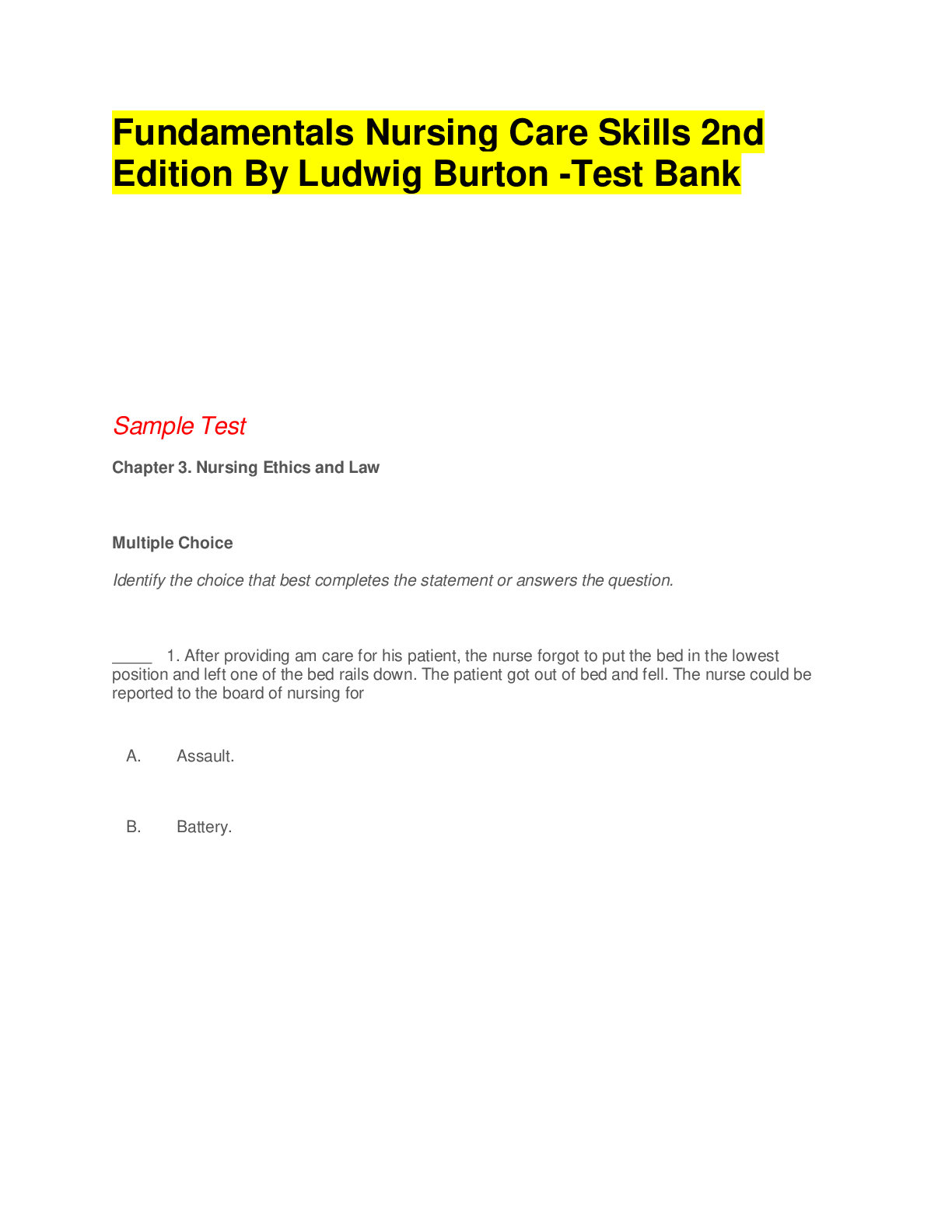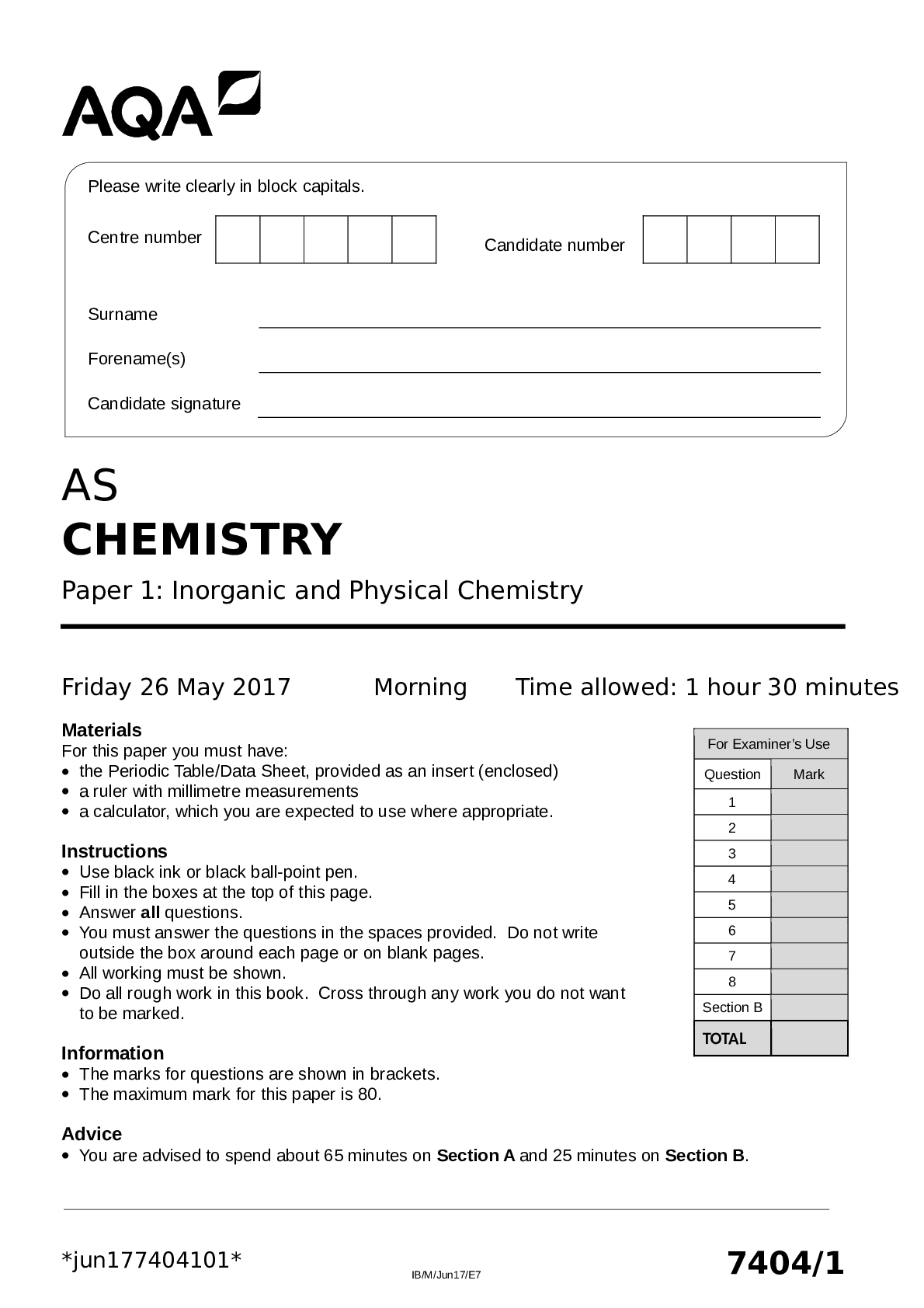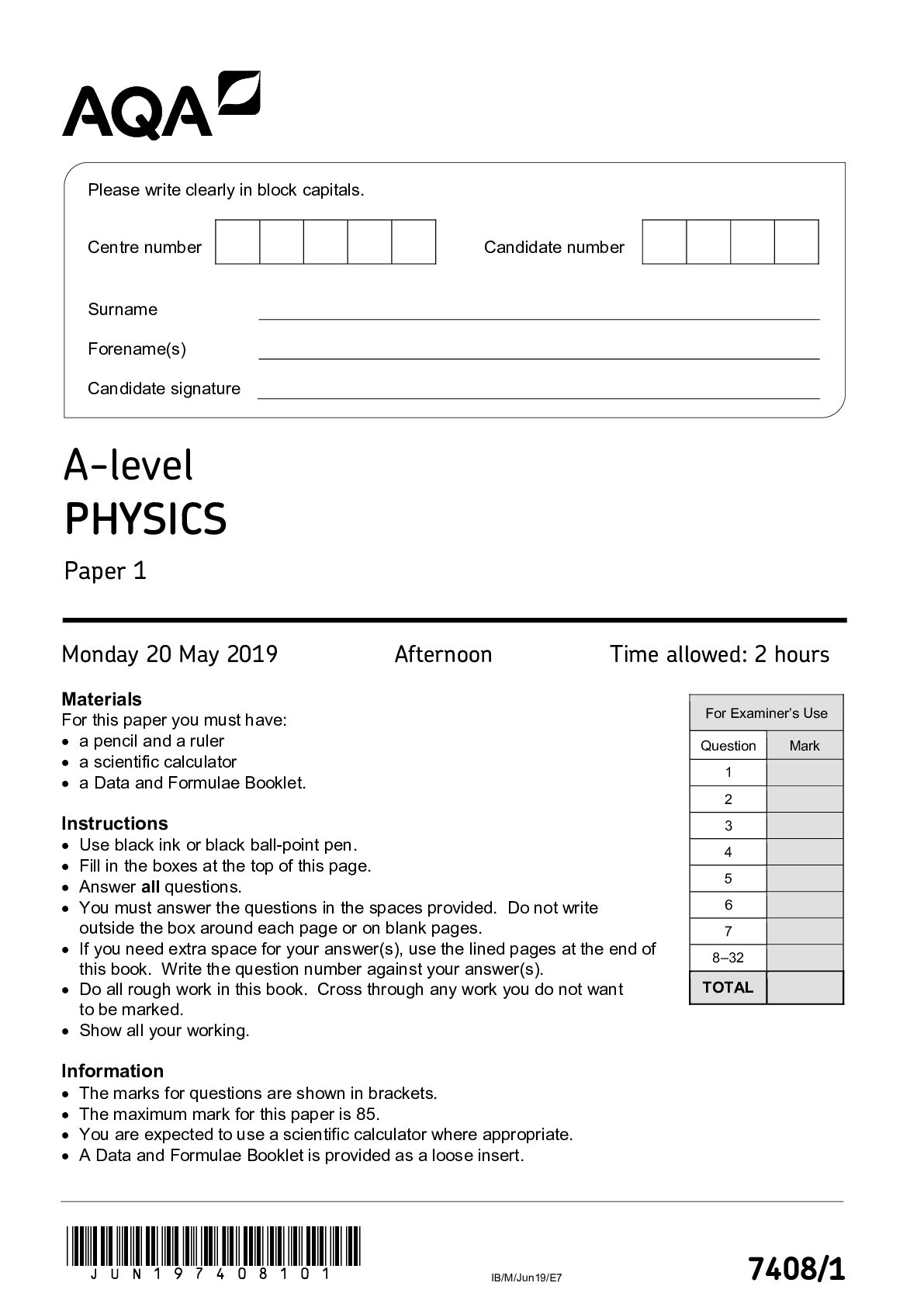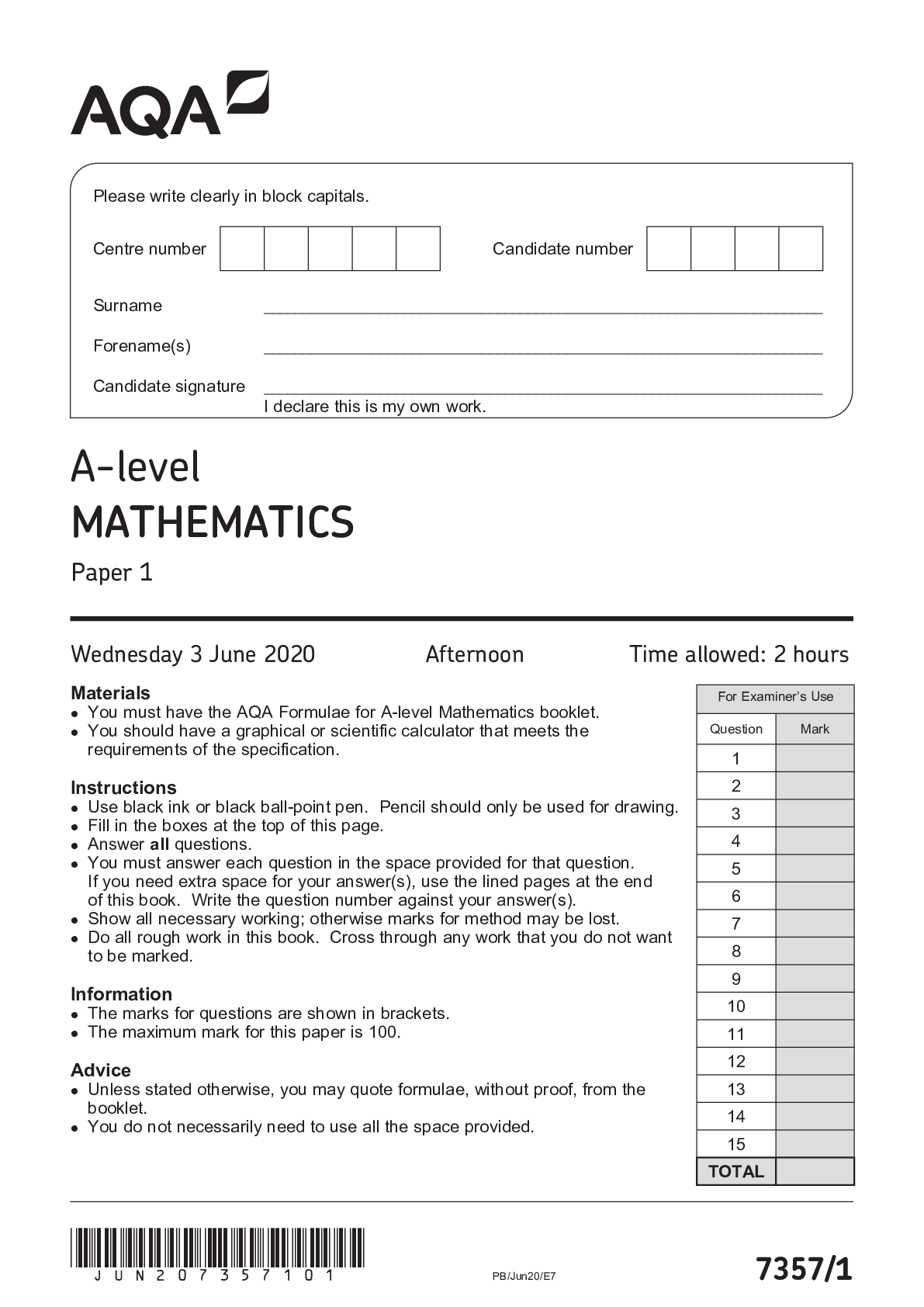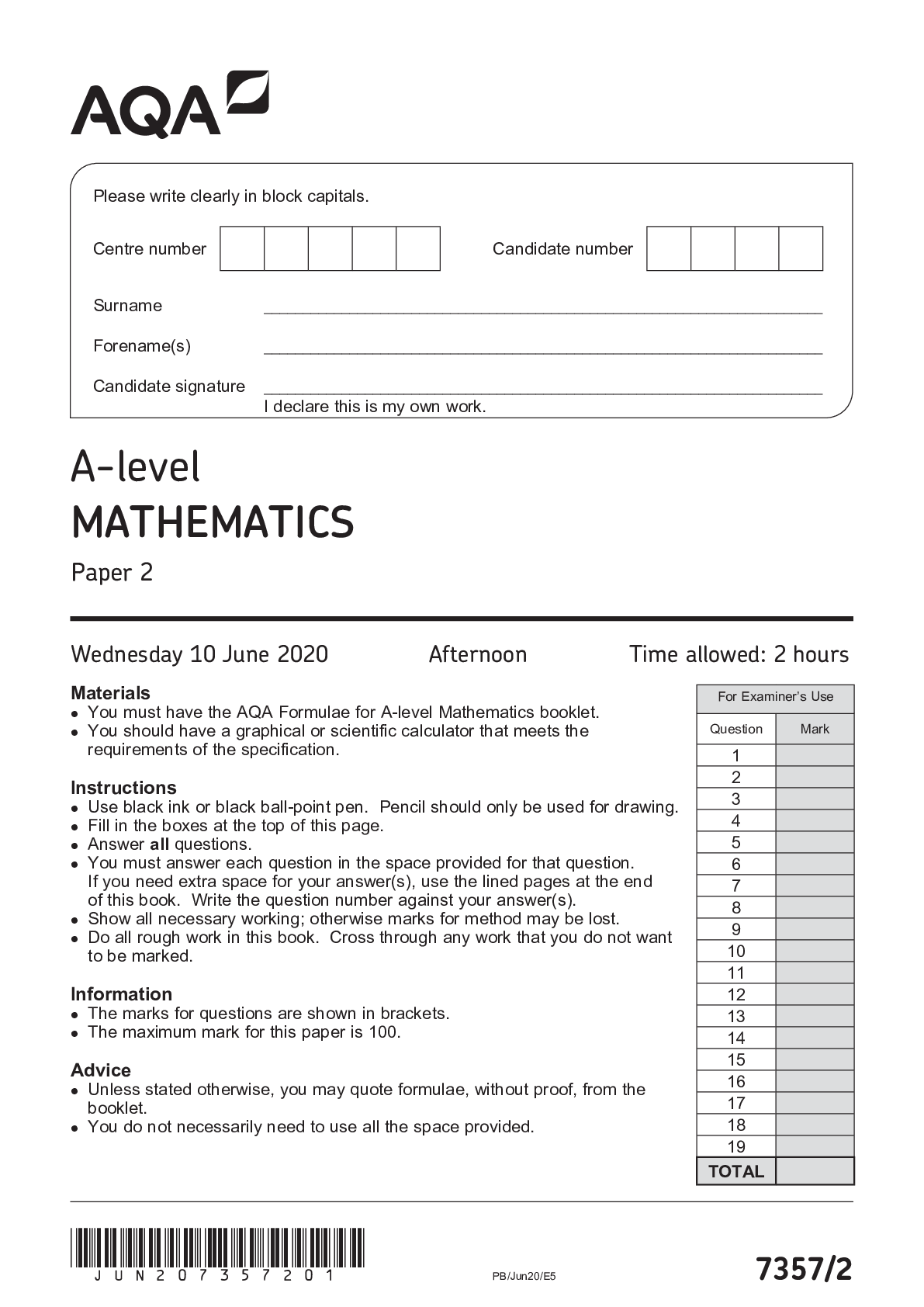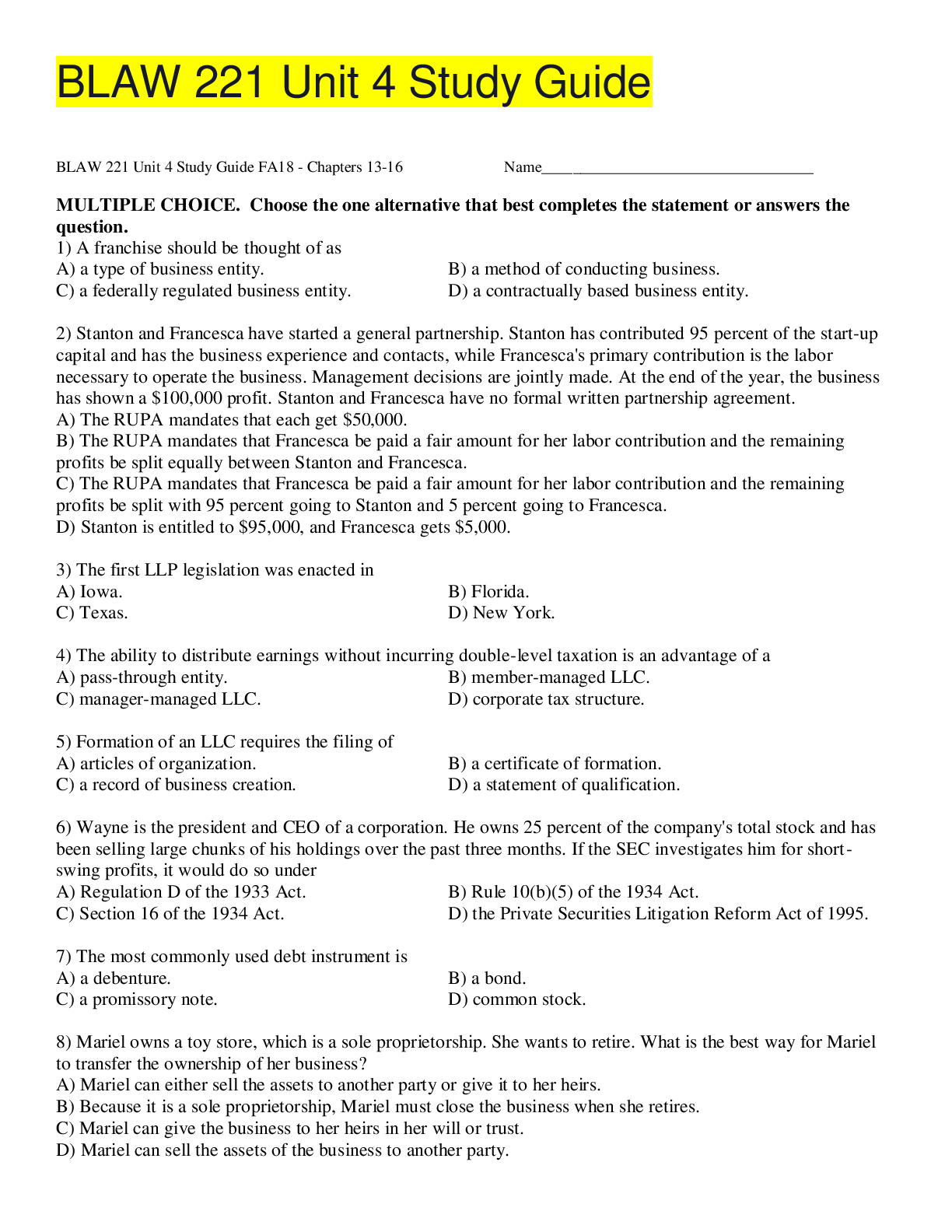*NURSING > QUESTION PAPER (QP) > NR 293 Week 6 Assignment: ATI: Pharmacology Made Easy: Propylthiouracil (All)
NR 293 Week 6 Assignment: ATI: Pharmacology Made Easy: Propylthiouracil
Document Content and Description Below
NR293 Pharmacology Pre-class Questions Week 6 1. What are possible effects of drugs for treating growth hormone deficiency in children? Select all that apply. a. Higher blood sugar levels b. In... creased lipid mobilization c. Retention of potassium levels d. Increased retention of sodium e. Improved tissue-building processes Rationale: 2. What assessment finding indicates to the nurse that vasopressin has been effective? a. Relief of pain b. Increased urine specific gravity c. Increased serum albumin levels d. Decreased adrenocorticotropic hormone levels Rationale: 3. The nurse is caring for a patient who has vasodilatory shock. On further assessment, the nurse finds that the patient has persisting orthostatic hypotension even after the medication is administered. What reason does the nurse expect for the persistence? a. The patient is administered vasopressin and carbamazepine. b. The patient is administered somatropin and glucocorticoids. c. The patient is administered vasopressin and demeclocycline. d. The patient is administered desmopressin and carbamazepine. Rationale: 4. A patient is prescribed somatropin injection subcutaneously. Which nursing intervention promotes safe administration of the drug? a. Rotating the injection site b. Shaking the vial vigorously c. Administering in the ventral gluteal site d. Administering if the drug in the vial is cloudy Rationale: 5. The nurse is teaching a patient who is prescribed desmopressin and who has polyuria, polydipsia, and dehydration. Which statement by the patient indicates the need for additional teaching? a. "I will avoid taking demeclocycline." b. "I will avoid consuming alcohol along with the drug." c. "I will increase intake of juices and water in my diet." d. "I will take medicines immediately upon getting up in the morning." Rationale: 6. The nurse instructs a nursing student to administer vasopressin to a patient. The student observes visible particles in the vasopressin solution and notifies the nurse. What instruction will the nurse give the student to ensure safe administration of vasopressin? a. "Heat the medicine before administration." b. "Do not administer the drug to the patient." c. "Shake the medication before administration." d. "Keep the bottle in warm water before administration." Rationale: 7. The nurse is caring for a patient who is receiving levothyroxine. The patient asks when the symptoms of hypothyroidism will stop. What is the nurse's best answer? a. "The medication will be effective in a couple of days." b. "It can take 1 to 4 weeks before the medication is effective." c. "You will need to be patient, because this medication takes 2 months to start working." d. "This is long-term therapy, and it will take at least 6 weeks before the medication is effective." Rationale: 8. The nurse prepares to administer an initial dose of propylthiouracil to a patient with toxic nodular disease of the thyroid gland. What baseline patient assessment is a priority for the nurse before the start of therapy? a. Skin condition b. Leukocyte count c. Size of the thyroid d. Coloration of the urine Rationale: 9. A patient who is taking propylthiouracil complains, "It's been 10 days since I started taking the medication, but my hunger is still not suppressed." What advice will the nurse provide? a. "Increase the amount of fiber in your diet." b. "Your hunger will subside in another 10 days." c. "Take the drug on an empty stomach before breakfast." d. "Make an appointment with your primary health care provider." Rationale: 10. The nurse is caring for a patient who has hyperthyroidism. The primary health care provider has prescribed methimazole. Which is the first and most important nursing action in this situation? a. Assess the patient's urine output. b. Assess signs of cardiac irregularities. c. Assess the patient's serum creatinine levels. d. Assess signs and symptoms of thyroid storm. Rationale: 11. The nurse is assessing a patient who has been taking propylthiouracil for the past 2 weeks and has normal thyroid-stimulating hormone (TSH) levels. For what symptom will the nurse primarily monitor the patient? a. Loss of appetite b. Cold intolerance c. Heart palpitations d. Unexplained weight gain Rationale: 12. During an assessment, a patient asks the nurse, "What should I do if I miss two or three doses of thyroid replacement drug in a row?" What is the best response given by the nurse? a. "You can take the dose immediately when you remember it." b. "Skip the missed dose and resume your usual dosage schedule." c. "You should consult your primary health care provider immediately." d. "If it is almost time for your next dose; at that time take a double dose of drug." Rationale: 13. Which technique is most appropriate regarding mixing insulin when the patient must administer 30 units regular insulin and 70 units NPH insulin in the morning? a. Use the Z-track method for administration. b. Draw the medication into two separate syringes but inject it into the same spot. c. Draw up the regular insulin into the syringe first, followed by the cloudy NPH insulin. d. Administer these insulins at least 10 minutes apart so that you will know when they are working. Rationale: 14. A patient newly diagnosed with type 2 diabetes mellitus has been ordered insulin glargine. What information is essential for the nurse to teach this patient? a. "This medication has a duration of action of 24 hours." b. "This medication should be mixed with the regular insulin each morning." c. "This medication is very short-acting. You must be sure you eat after injecting it." d. "This medication is very expensive, but you will be receiving it only a short time." Rationale: 15. A patient with type 1 diabetes mellitus has been ordered insulin aspart 10 units at 7:00 AM. What nursing intervention will the nurse perform after administering this medication? a. Flush the IV. b. Perform a fingerstick blood sugar test. c. Have the patient void and dipstick the urine. d. Make sure the patient eats breakfast immediately. Rationale: 16. What will the nurse teach a patient who takes metformin for type 2 diabetes? a. "You should take the medication with food." b. "You should report any nausea immediately." c. "If you miss a meal, you should skip the dose." d. "You have an increased risk of lactic acidosis." Rationale: 17. The nurse would include which statement when teaching a patient about insulin glargine? a. "You can mix this insulin with NPH insulin to enhance its effects." b. "You cannot mix this insulin with any other insulin in the same syringe." c. "You should inject this insulin just before meals because it is very fast-acting." d. "The duration of action for this insulin is approximately 8 to 10 hours, so you will need to take it twice a day." Rationale: 18. The nurse administers NPH insulin at 8:00 AM. What intervention is essential for the nurse to perform? a. Monitor fingerstick at 2:00 PM. b. Make sure patient eats by 5:00 PM. c. Administer the insulin via IV pump. d. Assess the patient for hyperglycemia by 10:00 AM. Rationale 19. A patient with a history of asthma frequently receives prednisone for acute bronchitis. Which adverse effects should the nurse anticipate that the patient may experience with continuous use of the therapy? Select all that apply. a. Weight gain b. Hypoglycemia c. Increased sleep d. Personality changes e. Loss of muscle bulk f. Loss of bone density Rationale: 20. A patient who has been receiving long-term corticosteroid therapy has undergone surgery for the treatment of an abdominal hernia. Which potential effect of this therapy should the nurse expect to have the most impact on the patient’s recovery? a. Hypotension b. Osteoporosis c. Muscle weakness d. Delayed wound healing Rationale: 21. A patient is about to receive steroid therapy. For what symptom should the nurse assess the patient? a. Septic shock b. Rheumatoid arthritis c. Uncontrolled diabetes mellitus d. Chronic obstructive pulmonary disease Rationale: 22. The nurse teaches a patient receiving long-term corticosteroid drug therapy about the dosage regimen. Which response by the patient indicates the need for further teaching? a. "I will take this medication with food or milk regularly." b. "I will not touch or interact with people who have infections." c. "I will stop taking this medication if I have any adverse effects." d. "I will report to you immediately if I have fever or a sore throat." Rationale: 23. The nurse is caring for a patient who has hypertension and is on continuous corticosteroid therapy to treat adrenal insufficiency. The electrocardiograph shows a steady slowing of the patient’s heart beat. The patient’s blood pressure is 140/96 mm Hg. Which drug is the nurse most likely to find while reviewing the patient’s medication history? a. Hydantoins b. Barbiturates c. Cholinergics d. Loop diuretic Rationale: 24. A patient is prescribed an aluminum-containing antacid for hyperacidity. The nurse should inform the patient about which possible adverse effect? a. Diarrhea b. Flatulence c. Constipation d. Muscle twitching Rationale: 25. A patient with hyperacidity who was prescribed an aluminum-containing antacid reports constipation, headache, and dry mouth. On assessment, the nurse finds that the patient has high blood pressure. What can the nurse interpret from these symptoms? a. The patient has renal failure. b. The patient has a gastric tumor. c. The patient has hypercalcemia. d. The patient has thrombocytopenia. Rationale: 26. A patient has been taking aluminum hydroxide to treat gastric hyperacidity for a few days. The patient reports being constipated. Which drug will the provider order in addition to aluminum hydroxide? a. Sodium citrate b. Magnesium hydroxide c. Aluminum carbonate d. Calcium carbonate Rationale: 27. The primary health care provider prescribes a rapid-release form of famotidine to be given intravenously. What will the nurse monitor in the patient while administering the drug? a. If the patient has eaten b. If the patient has swallowed the drug c. If the patient has alterations in cognition d. If there are alterations in the patient’s blood pressure Rationale: 28. A patient with hypertension reports pain in the abdomen, for which the primary health care provider plans to prescribe antacids. Which assessment in the patient is most important in planning the medication regimen? a. Duration of abdominal pain b. Activity level of the patient c. Previous and current prescriptions d. Patient’s adherence to the treatment regimen Rationale: 29. Which patient statements indicate effective learning about bisacodyl therapy? Select all that apply. a. "I should take the tablets along with antacids." b. "I should take the tablets on an empty stomach." c. "I should take the tablets within 1 hour of drinking milk." d. "I should not drink juice within 1 hour of taking the tablets." e. "I should take the tablets without crushing them into powder." Rationale: 30. The nurse is assessing a patient who took senna for constipation. The nurse teaches the patient about what potential side effect? a. Lethargy b. Dizziness c. Bloody stools d. Abdominal pain Rationale: 31. A patient states, “My stools are black! What should I do?” The patient is taking bismuth subsalicylate. What does the nurse do first? a. Stop the medication. b. Administer diphenhydramine. c. Call the health care provider immediately. d. Reassure the patient that this is an expected side effect of the medication. Rationale: 32. What actions will the nurse take during the insertion of a rectal suppository? Select all that apply. a. Insert the suppository as far as possible into the rectum. b. Wear gloves or a finger cot while inserting the suppository. c. Place the patient on the left side while inserting the suppository. d. Place the patient in a supine position for 30 minutes after insertion. e. Lubricate the suppository with water-soluble gel before insertion. Rationale: 33. A patient is taking a stimulant laxative. What should the nurse teach the patient for safe usage? a. "This medication has to be taken with food." b. "Do not take this medication in the morning." c. "Hold other medications when taking this drug." d. "This medication can cause electrolyte and nutrient imbalances." Rationale: 34. Which category of laxatives is contraindicated in elderly patients? a. Emollient laxatives b. Stimulant laxatives c. Bulk-forming laxatives d. Hyperosmotic laxatives Rationale: 35. The nurse is caring for a patient who is 2 months pregnant and is experiencing morning sickness. Which antinausea drug would the nurse expect to be prescribed for the patient? a. Dolasetron b. Palonosetron c. Promethazine d. Ondansetron Rationale: 36. The nurse plans to administer 50 mg of diphenhydramine intravenously. How will the nurse administer this medication? a. Undiluted over 1 minute b. Undiluted over 2 minutes c. Diluted in 100 mL D5W over 20 minutes d. Diluted in 50 mL normal saline over 30 minutes Rationale: 37. A patient who is receiving chemotherapy has developed nausea and vomiting. Which drug will the nurse expect to be added to the treatment plan along with the chemotherapeutic agent? a. Ondansetron b. Scopolamine c. Promethazine d. Diphenhydramine Rationale: 38. The nurse assesses a hospitalized patient who has nausea and vomiting who has been prescribed promethazine. What side effect might the nurse expect in this patient? a. Decreased risk of tissue damage b. Increased risk of encephalopathy c. Increased risk of low blood pressure d. Increased risk of bone marrow suppression Rationale: 39. Before administering the anticholinergic drug scopolamine, the nurse would be careful to assess the patient for a history of which condition? a. Glaucoma b. Gastroenteritis c. Hyperthyroidism d. Rheumatoid arthritis Rationale: 40. The nurse is caring for a patient who has nausea and vomiting and is prescribed metoclopramide. The nurse instructs the patient about what possible side effect? a. Hypertension b. Bronchospasm c. Motion sickness d. Tardive dyskinesia Rationale: [Show More]
Last updated: 1 year ago
Preview 1 out of 13 pages
Instant download
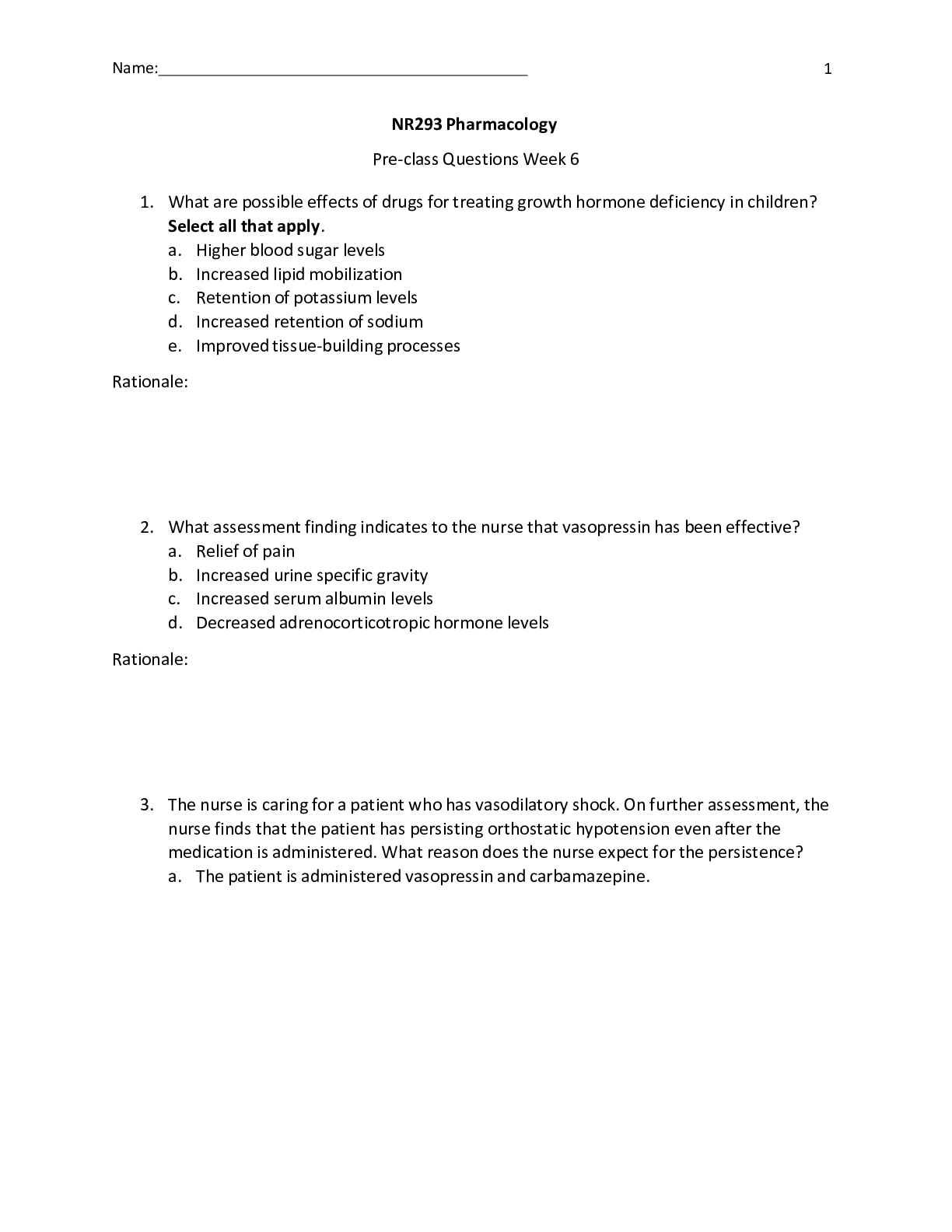
Buy this document to get the full access instantly
Instant Download Access after purchase
Add to cartInstant download
Also available in bundle (1)
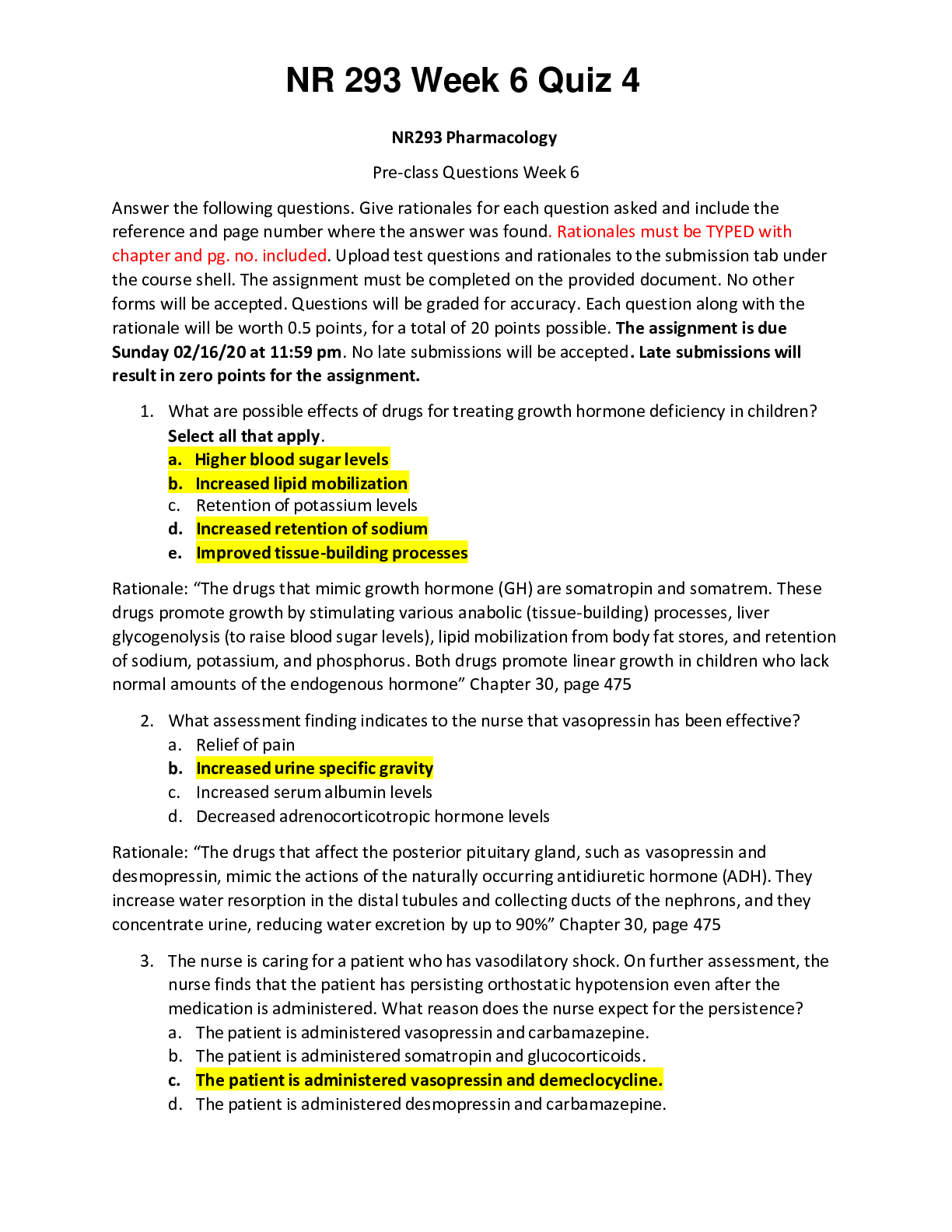
NR 293 WEEK 1-6 Assignments, Discusssion, ESSAY"S, Reports, Quiz and EXAMS | 100% GUARANTEED SATISFACTION.
NR 293 WEEK 1-6 Assignments, Discusssion, Quiz and EXAMS | 100% GUARANTEED SATISFACTION.
By A+ Solutions 2 years ago
$14
16
Reviews( 0 )
Document information
Connected school, study & course
About the document
Uploaded On
Sep 03, 2021
Number of pages
13
Written in
Additional information
This document has been written for:
Uploaded
Sep 03, 2021
Downloads
0
Views
67

